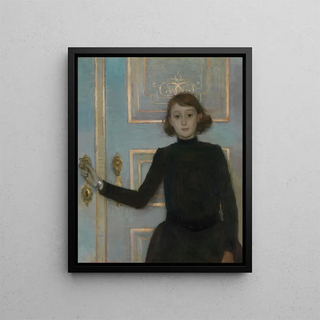Art print | Portrait of Marguerite van Mons - Theo van Rysselberghe


View from behind

Frame (optional)
The "Portrait of Marguerite van Mons" by Theo van Rysselberghe is a work that transcends the simple frame of a figurative representation to delve into the intimacy of an era. Created at the end of the 19th century, this painting not only bears witness to the undeniable talent of the artist but also reflects the artistic vibrancy of the neo-impressionist movement. Gazing upon this piece, one is immediately transported into the delicate and refined world of Belgian bourgeoisie, where each brushstroke seems to whisper the story of a woman and a society in full transformation. Marguerite van Mons, a central figure in this portrait, embodies the elegance and sophistication of a bygone era, while also reflecting the aspirations and challenges of her time.
Style and uniqueness of the work
Theo van Rysselberghe's technique is characterized by a pointillist approach, typical of neo-impressionism. His use of small touches of color, carefully juxtaposed, creates a luminosity and depth that bring his subject to life. In the "Portrait of Marguerite van Mons," the delicate nuances of the model's skin and the reflections of her dress are rendered with such precision that one almost feels the texture of the fabrics and the warmth of her presence. The color palette chosen by the artist, blending soft tones with subtle contrasts, evokes an atmosphere that is both intimate and contemplative. This portrait does not merely capture Marguerite's appearance; it also conveys her essence, personality, and social status, while offering a reflection on the role of women during that period.
The artist and his influence
Theo van Rysselberghe, an emblematic figure of the neo-impressionist movement, masterfully combined technique and sensitivity in his work. Strongly influenced by masters such as Georges Seurat, he nonetheless developed a unique style, deeply rooted in his era. His ability to capture light and color allowed him to stand out in the Belgian and international artistic landscape. By painting Marguerite van Mons, he does not just create a portrait; he immortalizes a moment, an emotion, a story. The artist also played a

Matte finish

View from behind

Frame (optional)
The "Portrait of Marguerite van Mons" by Theo van Rysselberghe is a work that transcends the simple frame of a figurative representation to delve into the intimacy of an era. Created at the end of the 19th century, this painting not only bears witness to the undeniable talent of the artist but also reflects the artistic vibrancy of the neo-impressionist movement. Gazing upon this piece, one is immediately transported into the delicate and refined world of Belgian bourgeoisie, where each brushstroke seems to whisper the story of a woman and a society in full transformation. Marguerite van Mons, a central figure in this portrait, embodies the elegance and sophistication of a bygone era, while also reflecting the aspirations and challenges of her time.
Style and uniqueness of the work
Theo van Rysselberghe's technique is characterized by a pointillist approach, typical of neo-impressionism. His use of small touches of color, carefully juxtaposed, creates a luminosity and depth that bring his subject to life. In the "Portrait of Marguerite van Mons," the delicate nuances of the model's skin and the reflections of her dress are rendered with such precision that one almost feels the texture of the fabrics and the warmth of her presence. The color palette chosen by the artist, blending soft tones with subtle contrasts, evokes an atmosphere that is both intimate and contemplative. This portrait does not merely capture Marguerite's appearance; it also conveys her essence, personality, and social status, while offering a reflection on the role of women during that period.
The artist and his influence
Theo van Rysselberghe, an emblematic figure of the neo-impressionist movement, masterfully combined technique and sensitivity in his work. Strongly influenced by masters such as Georges Seurat, he nonetheless developed a unique style, deeply rooted in his era. His ability to capture light and color allowed him to stand out in the Belgian and international artistic landscape. By painting Marguerite van Mons, he does not just create a portrait; he immortalizes a moment, an emotion, a story. The artist also played a






